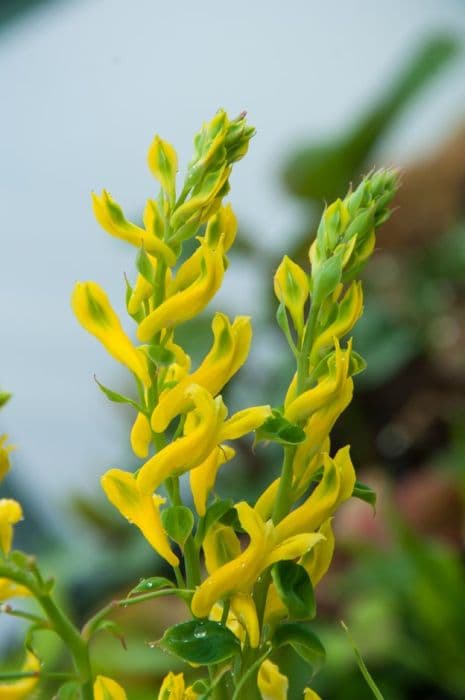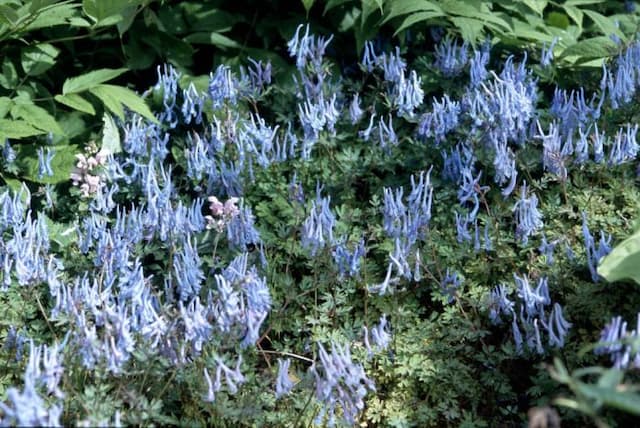Blue corydalis Corydalis flexuosa 'China Blue'

ABOUT
China Blue is a captivating perennial plant with a delicate yet striking appearance. Its most notable feature is the beautiful, rich blue flowers that bloom profusely, creating a cool and tranquil effect in any garden setting. These distinct flowers are tubular and somewhat pendant, reminiscent of little lanterns suspended amidst the foliage. They are arranged in loose clusters at the tips of branching stems, and their vivid hue is truly enchanting. The leaves of China Blue are equally attractive, composed of finely divided, fern-like foliage that is a soft green in color. This lacy, intricate leaf structure adds a layer of textural contrast against the bold blue of the flowers, making this plant not only about the blooms but also its elegant greenery. The entire plant presents a somewhat mounded shape, with the foliage forming an effective backdrop to the showy blooms that rise just above. Its ground-covering nature and the way the stems gently sway in the breeze make it a perfect choice for creating a serene and picturesque spot in a shaded area where such plants thrive. Overall, China Blue is a wonderful addition to any garden, providing a delicate touch of cool color that pairs well with other shade-loving plants. Its picturesque blooms and ornamental leaves create a charming display that is highly appreciated by gardeners and nature enthusiasts alike.
About this plant
 Names
NamesFamily
Papaveraceae.
Synonyms
Blue Corydalis, Chinese Corydalis, China Blue.
Common names
Corydalis flexuosa 'China Blue'.
 Toxicity
ToxicityTo humans
Blue Corydalis is generally considered non-toxic to humans. There is limited information on the toxicity of Blue Corydalis, but it is not typically recognized as a poisonous plant, and there are no well-documented cases of poisoning from ingesting this plant. However, as with any plant, it is advisable to avoid ingestion and to exercise caution, since individual reactions can vary.
To pets
Blue Corydalis is also not known to be toxic to pets. There is a lack of specific information regarding its effects on animals, but it is not listed among the commonly recognized poisonous plants for pets. Despite the lack of known toxicity, it is still wise to prevent pets from ingesting plants, as they can have individual sensitivities or allergic reactions.
 Characteristics
CharacteristicsLife cycle
Perennials
Foliage type
Deciduous
Color of leaves
Green
Flower color
Blue
Height
1 foot (30 centimeters)
Spread
1 foot (30 centimeters)
Plant type
Herb
Hardiness zones
5
Native area
China
Benefits
 General Benefits
General Benefits- Attracts Pollinators: Corydalis flexuosa 'China Blue', commonly known as Chinese Corydalis, is known to attract bees and butterflies, which are essential for the pollination of many plants.
- Garden Aesthetics: The vibrant blue flowers add a beautiful splash of color to garden landscapes and borders.
- Ease of Care: Chinese Corydalis is a low-maintenance plant that is relatively easy to grow and care for in a variety of garden settings.
- Shade Tolerance: It can thrive in partial shade, which makes it suitable for planting under trees or in shadowed parts of the garden where other plants might struggle.
- Seasonal Interest: This plant has a long blooming period, usually from spring through the summer, providing continued interest in the garden.
- Complementary Planting: Chinese Corydalis coordinates well with other shade-loving plants, making it ideal for woodland gardens or shaded rock gardens.
- Container Gardening: It can be successfully grown in pots and containers, offering versatility in placement and garden design.
 Medical Properties
Medical PropertiesThis plant is not used for medical purposes.
 Air-purifying Qualities
Air-purifying QualitiesThis plant is not specifically known for air purifying qualities.
 Other Uses
Other Uses- Corydalis flexuosa 'China Blue', also known as Blue corydalis, can be utilized in dye production, as the roots may contain pigments that could yield subtle colors when processed.
- Blue corydalis is an option for cut flower arrangements when in bloom, offering a delicate, whimsical appearance with its nodding blue flowers.
- With their ornamental foliage, Blue corydalis could be grown for use in pressed flower art, preserving the intricate leaf patterns in various crafts.
- The seeds of Blue corydalis have been used in tradition to feed birds, especially in aviaries, as part of a complex diet to cater to their nutritional needs.
- Used in perfumery, the subtle fragrance of Blue corydalis flowers could be extracted to contribute to floral scents, particularly in artisanal or niche perfumes.
- When grown in large amounts, Blue corydalis can be included in green roof planting to help insulate buildings and add biodiversity to urban environments.
- Dried Blue corydalis can be used in potpourri blends, bringing a visual element to the mix with its blue tinted foliage and flowers amidst other dried plants.
- In biodynamic farming, Blue corydalis may be planted in a way that follows lunar cycles, contributing to diverse planting which also helps attract beneficial insects.
- During their off-season, the dense fern-like foliage of Blue corydalis could serve to provide ground cover to prevent soil erosion in gardens and parks.
- Blue corydalis could be used as a natural ink source for artists interested in creating their own botanical inks from various plant materials for use in paintings, drawings, or calligraphy.
Interesting Facts
 Feng Shui
Feng ShuiThe Blue Corydalis is not used in Feng Shui practice.
 Zodiac Sign Compitability
Zodiac Sign CompitabilityThe Blue Corydalis is not used in astrology practice.
 Plant Symbolism
Plant Symbolism- Elusiveness – Corydalis flexuosa, or Blue Corydalis, is known for its fleeting appearance. It blooms early in the spring but often goes dormant during the summer, symbolizing the transient and elusive nature of beauty or opportunities.
- Tranquility – The serene blue color of its flowers is often associated with calmness and tranquility, reflecting a sense of peace and relaxation.
- Joy – Blue Corydalis has a light and airy appearance, with delicate flowers that seem to dance in the breeze. This can symbolize joy and the lightness of being.
 Water
WaterBlue corydalis should be watered when the top inch of soil feels dry to the touch. Typically, this might equate to watering about once a week, but the frequency can vary depending on environmental conditions. When watering, use lukewarm water and gently soak the soil until water runs through the drainage holes, which could be around one-half gallon for an average-sized pot. During the growing season in spring and summer, the plant may require more frequent watering, such as every few days. It is crucial to ensure that the pot provides adequate drainage to prevent waterlogging.
 Light
LightBlue corydalis thrives in partial to full shade conditions, making it perfect for a woodland garden or a shady area that doesn't receive direct afternoon sunlight. The ideal spot is one where the plant will receive dappled sunlight in the morning and shade during the heat of the day. Direct sun can scorch the delicate leaves, so avoid placing it in a location that gets intense sun.
 Temperature
TemperatureBlue corydalis prefers a cool to moderate temperature range with ideal conditions between 50°F and 75°F. It can tolerate minimum temperatures down to 20°F and maximum temperatures up to 80°F, but extreme temperatures may affect the plant's health and flowering capability. To ensure the best growth, it should be protected from harsh winter winds and extremely hot summer sunlight.
 Pruning
PruningPruning blue corydalis is mainly for aesthetic purposes and to remove spent flowers or any yellowed or dead foliage. Light pruning can be done in spring or after the first flush of flowers to promote a second blooming. Typically, this plant requires pruning once or twice a year. It's a gentle process that doesn't require rigorous cutting back unless the plant becomes too large for its intended space.
 Cleaning
CleaningAs needed
 Soil
SoilChina Blue needs well-draining soil with a pH between 6.5 and 7.5 for optimal growth. A mixture containing equal parts of garden soil, peat, and perlite or sand is ideal to ensure proper moisture retention and drainage.
 Repotting
RepottingChina Blue, also known as Chinese Blue Corydalis, should typically be repotted every 2 to 3 years to refresh the soil and allow for root growth.
 Humidity & Misting
Humidity & MistingChinese Blue Corydalis thrives in average to high humidity conditions; maintaining humidity levels around 50-70% is optimal for its health.
 Suitable locations
Suitable locationsIndoor
Place China Blue in a shaded spot with moist soil.
Outdoor
Plant China Blue in partial shade, with moist, well-draining soil.
Hardiness zone
5-8 USDA
 Life cycle
Life cycleThe life cycle of Corydalis flexuosa 'China Blue', commonly known as the Blue Corydalis, begins with seed germination, which occurs in moist, well-drained soils in a shady environment, typically in the spring. Once the seedlings emerge, they develop into rosettes of finely dissected, fern-like blue-green leaves. The plant enters its vegetative stage, during which it grows and establishes a strong root system. Following this, in late spring to early summer, the Blue Corydalis produces characteristic intense blue, tubular flowers arranged in racemes, attracting pollinators. After pollination, the plant sets seed in the form of elongated capsules that eventually dry and release seeds, completing the reproductive cycle. Finally, the plant may enter a dormancy period in the heat of the summer, especially in hotter regions, before reemerging when cool temperatures return.
 Propogation
PropogationPropogation time
Spring to Summer
The most popular method of propagating the China Blue Corydalis, or Corydalis flexuosa 'China Blue', is through the division of its tubers. This is best done in the fall after the plant has finished flowering and the foliage has died back. The tubers should be carefully dug up using a garden fork to avoid damage. Once out of the ground, they can be gently pulled apart, ensuring that each division has at least one growth bud. These divisions should then be replanted immediately at the same depth they were growing before, spaced about 12 inches (approximately 30 centimeters) apart, and watered thoroughly. This method enables the gardener to produce mature plants much more quickly than by seed, and it also helps to rejuvenate older clumps that may have become too dense.









